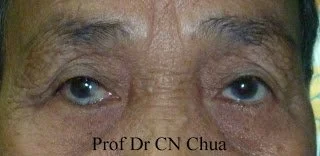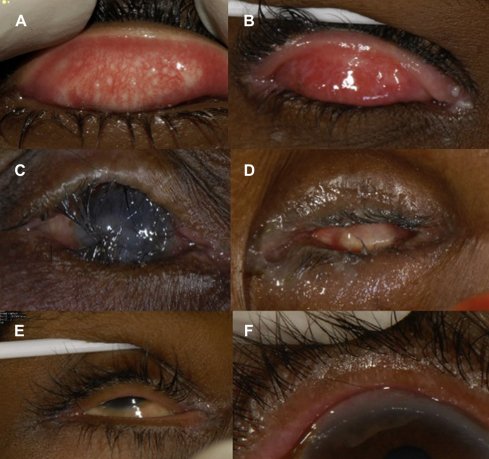Common eyelid problems related to dry eye disease, Part 4: The eyelid “innie.”
Part 4: When eyelids turn in the wrong direction: Entropion = turns in
https://eyewiki.aao.org/Entropion
Right Lower Eyelid is turning/rolling inward (entropion) - and putting the lashes against the white part of the eye (trichiasis).
Entropion (or inward turning lids) will result in the lashes rubbing on the conjunctival and/or corneal surfaces (called trichiasis), so that the surface can become scratched and irritated. This can be more destructive than when the lid turns out, in that continuous rubbing of lashes is a bit like adding a hairbrush to the blink. This accelerates making normally smooth conjunctival membranes red and rough, but when directed against the delicate cornea (the clear “window” of the eye) this “hairbrush” called trichiasis, can cause stronger irritations and larger, more painful scratches/abrasions. Adding the mix of germs that like to live along the base of eyelashes and the lid margin into those “open sores” is a potential recipe for disaster. As is also true for ectropion, corneas do not feel good, nor do they see well when they are dry, rough or continually scratched but can go bad in a hurry when infected.
To fix an Entropion, it is important to determine the cause, and surgery may often be required. Like ectropion, not excessively rubbing the eyes helps avoid the stretching and weakening of the ligaments that support the lid in its normal position. Weak ligaments allow the “hammock” to tip - in this case, inward. If the cause is “floppiness” (see my upcoming post on floppy eyelids and related sleep apnea), then dealing with the sleep apnea can often help stop further floppiness and may help repair it over time. When there is entropion-related lash rubbing/scratching (trichiasis), then it is common to have reflex tearing, where the “fire hose” turns on and salty water floods the eye. This is less helpful, as the salt will sting the corneal sores caused by the scratching and salt water provides little lubrication. This can break down the surface quickly and can readily lead to infections, scarring and loss of vision.
Trachoma and related eye and eyelid disease
The clinical signs of trachoma. A: Active trachoma with both follicles and intense inflammation. B: Trachomatous conjunctival scarring. C: Entropion trichiasis and corneal opacity. D: Phthisis. E: Misdirected lashes. F: Metaplastic lashes. Surv Ophthalmol. 2012 Mar; 57-341(2): 105–135.
While rare in the USA, trachoma is still the leading cause of blindness in less developed countries - and will commonly lead to the inturning of the lids - with lid, and then corneal scarring. Fortunately, if caught early, it is easily treatable with the right antibiotics and preventable with good hygiene, as it is caused by a germ that is easily spread by personal contact and is therefore very contagious. Prior surgeries, injuries (especially chemical injuries) and chronic inflammation from infections (apart from trachoma) like blepharitis (see my earlier posts on this), or allergies, can also lead to degrees of this condition. Rare immune issues like Stevens-Johnson or Ocular Cicatricial Pemphigoid, as well as some persons born with this problem, also occur.
I should mention that lashes can turn in (trichiasis) without any inturning of the lid (entropion). These misdirected lashes can have a similar effect on the surface of the eye, but most often can be managed with selective removal of these lashes (see my earlier post on this here: https://www.eyethera.com/blog/0r1w3kiho48uaz4yydxlyrogx5xksf).
Having plenty of oil and healthful tears will help to lubricate and limit the scratching and help in repairing the roughened surfaces. However, it is hard to have the good blinks eyes need, when the lashes are rubbing with each blink. Better blinking would be beneficial to making those “good tears” but is hard to do until the lid position and “blink mechanics” are restored – so fixing the lid is often required to allow proper tear production and distribution.
When entropion is related to lid spasms (as can occur after any surgery on the eye), then a temporizing injection of Botox-like medication can quell the spasming until the eye is healed and the condition may not need much more treatment. Short-term “fixes” can be as simple as adding a piece of sticky tape that splints the loose lid, or pulls the lid out and away from the eye. A mild-to-moderate, in-office treatment can sometimes be offered using special dissolvable stitches to turn the lid outward, away from the eye (called Quickert sutures). This will create a certain amount of scarring and healing that can redirect the lid forces away from the eye, but will typically wear off over time. If an entropion is severe or progresses, then more surgery is generally required and may involve tightening the lid by surgically shortening it and then resuspending it to the natural “hammock attachment sites.” Surgically “re-draping” the muscles can help rebalance the “hammock,” when just re-suspending it, isn’t enough.
Many eyelid problems will be slower to occur if the eyelids get proper support and good care over one’s lifetime. Particularly, use of toxin-containing makeup materials, or, unchecked - the overgrowth of skin germs or environmental allergies, excess eyelid rubbing or stretching - these all add up to trouble and may result in this unwanted, unhealthy eyelid (and ocular surface) condition. Getting regular eye checkups and proper eye (and eyelid) care is essential to good eye health!
To schedule an appointment with Dr. Jaccoma, call Excellent Vision at either of these two dry eye offices:
(1) 155 Griffin Rd, Portsmouth, NH 03801 (603) 574-2020
(2) 3 Woodland Rd, STE 112 Stoneham, MA 02180 (near Boston) (781) 321-6463


